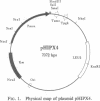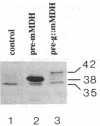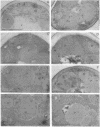Abstract
We have studied the significance of the N-terminal presequence of watermelon (Citrullus vulgaris) glyoxysomal malate dehydrogenase [gMDH; (S)-malate:NAD+ oxidoreductase; EC 1.1.1.37] in microbody targeting. The yeast Hansenula polymorpha was used as heterologous host for the in vivo expression of various genetically altered watermelon MDH genes, whose protein products were localized by immunocytochemical techniques. It is shown that the presequence of gMDH is essential and sufficient for peroxisomal targeting; it can target the mature part of the mitochondrial MDH to microbodies, whereas deletion of the presequence results in accumulation of the mature form of gMDH in the cytosol. Alignment of the N termini of several peroxisomal proteins that are assumed to contain a peroxisomal targeting signal at the N terminus (PTS2) suggested the consensus seqence RL-X5-HL. A similar motif is present in the presequence of watermelon gMDH--namely, 10RI-X5-17HL. Mutational analysis revealed that substitutions of 10RI into DD or 17HL into DE destroyed the topogenic information, whereas substitutions of 25M into I and 26EE into LV did not. By combining our data with recent analyses of others on the presequences of mammalian thiolases, it is concluded that the peroxisomal targeting information of PTS2 is contained in the consensus sequence RL/I-X5-HL. In contrast to the higher plant and mammals, the Hansenula yeast peroxisomes seem to lack an enzyme capable of removing microbody presequences of higher eukaryotes.
Full text
PDF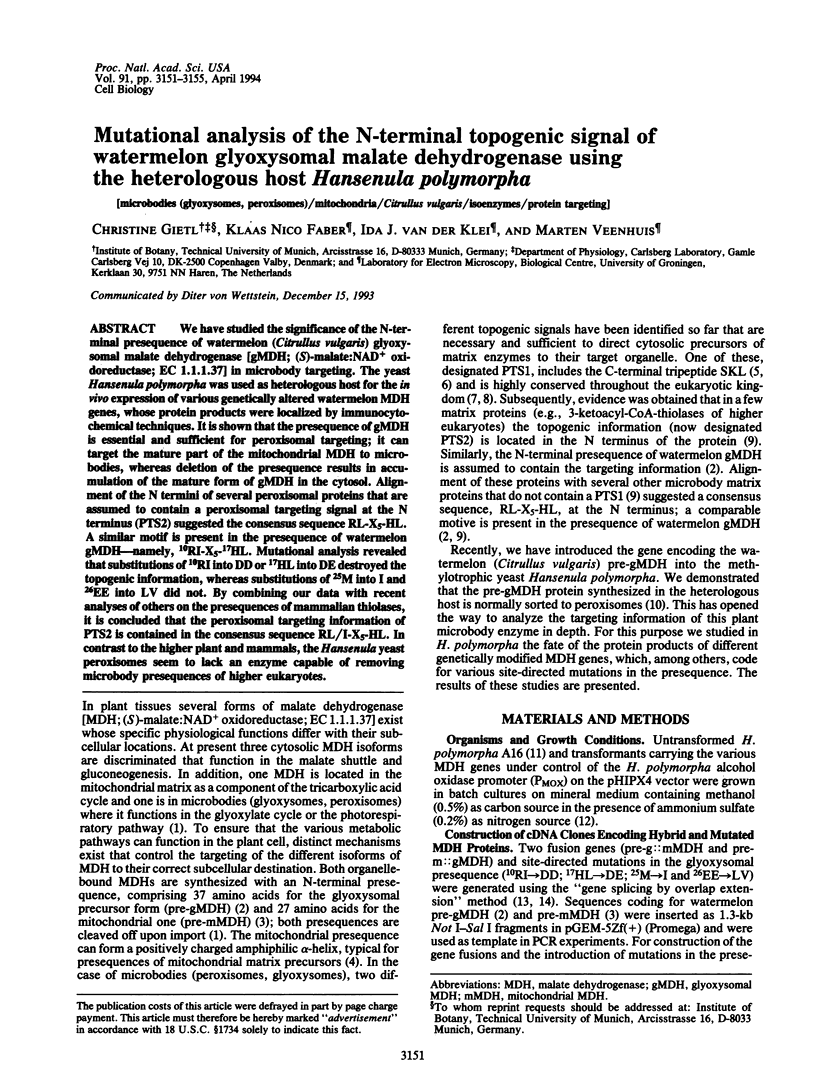
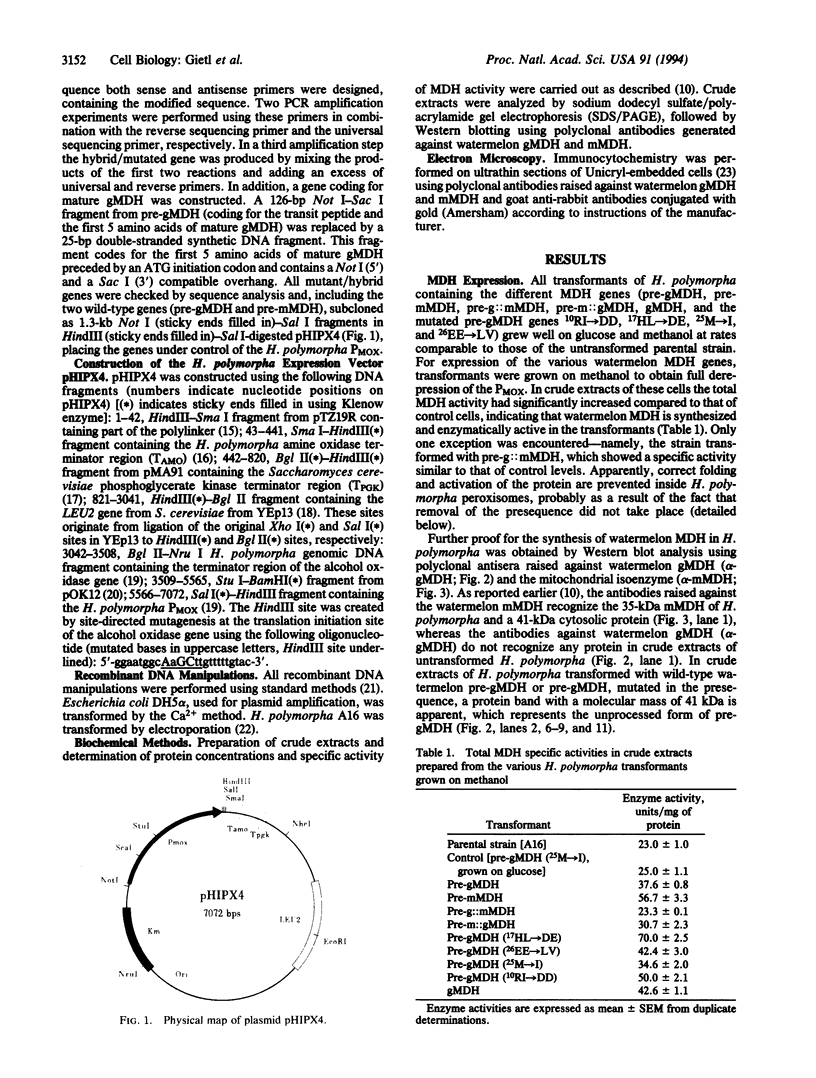
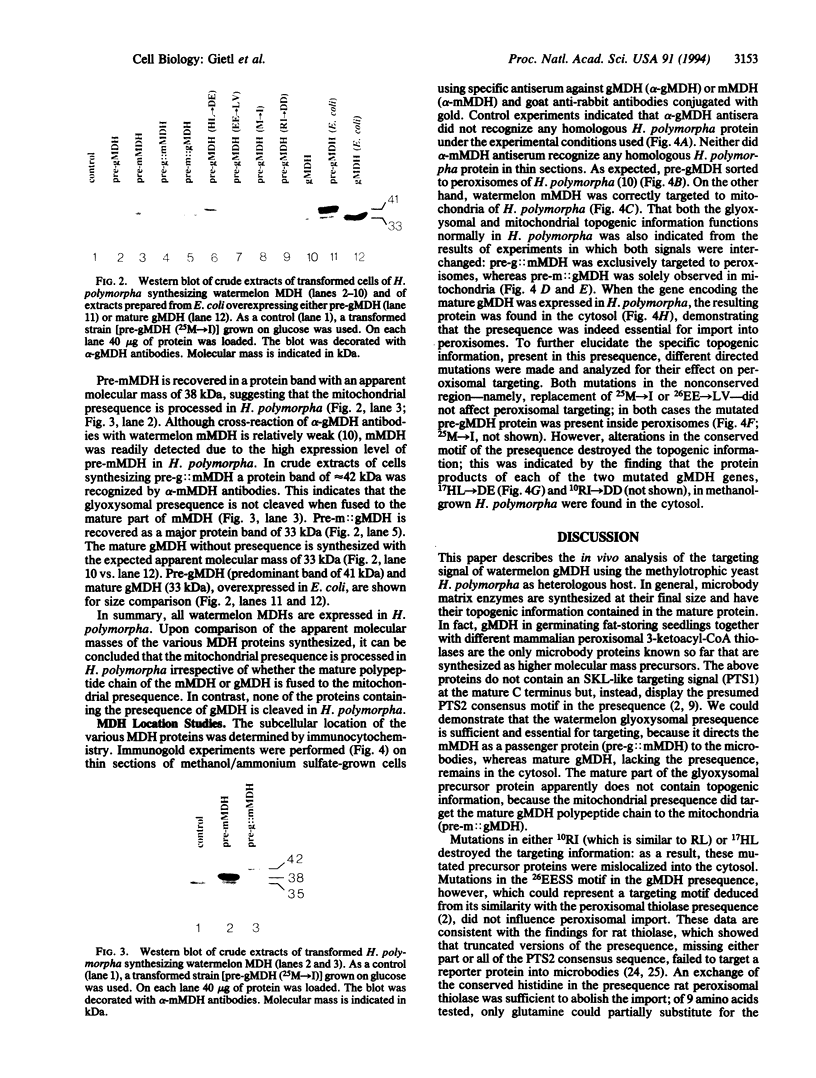
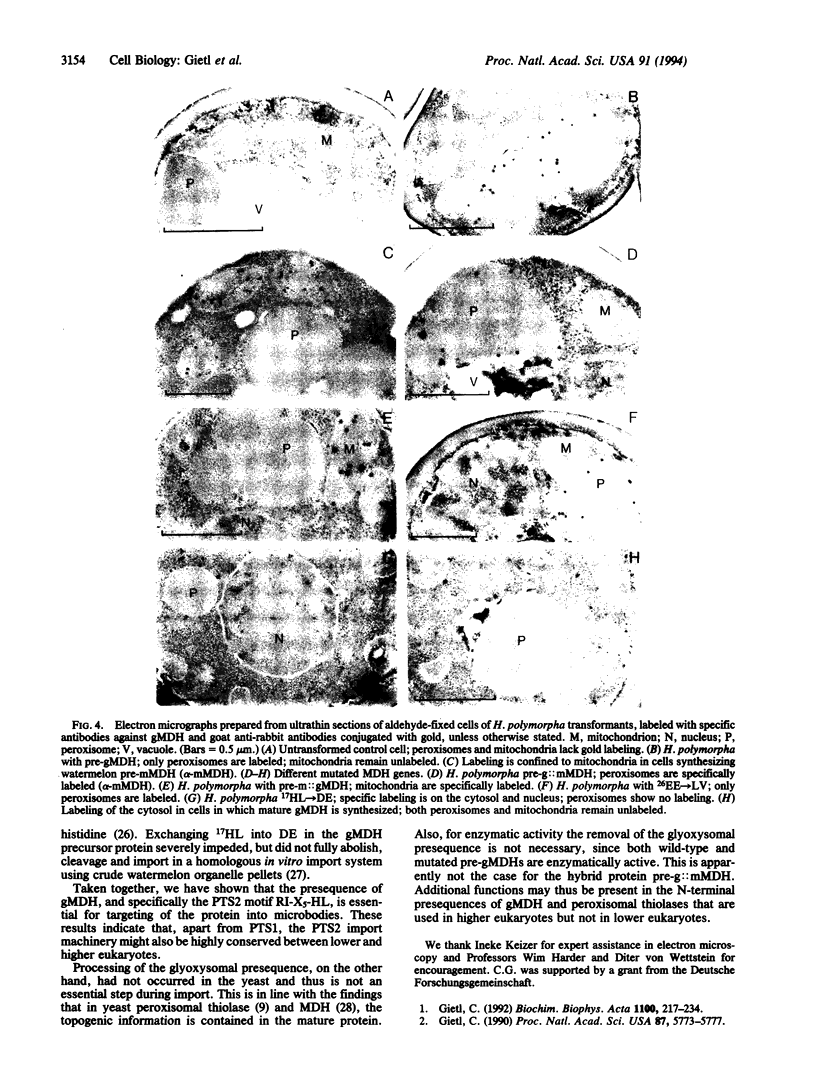
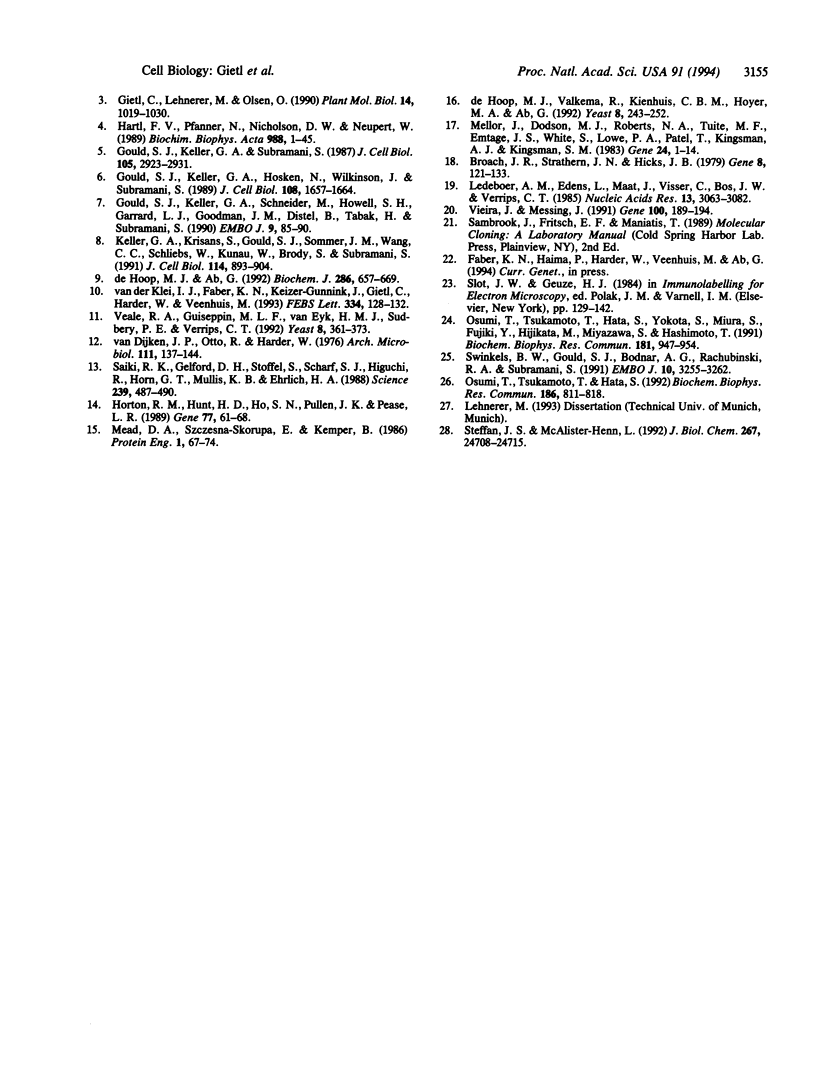
Images in this article
Selected References
These references are in PubMed. This may not be the complete list of references from this article.
- Broach J. R., Strathern J. N., Hicks J. B. Transformation in yeast: development of a hybrid cloning vector and isolation of the CAN1 gene. Gene. 1979 Dec;8(1):121–133. doi: 10.1016/0378-1119(79)90012-x. [DOI] [PubMed] [Google Scholar]
- De Hoop M. J., Valkema R., Kienhuis C. B., Hoyer M. A., Ab G. The peroxisomal import signal of amine oxidase from the yeast Hansenula polymorpha is not universal. Yeast. 1992 Apr;8(4):243–252. doi: 10.1002/yea.320080402. [DOI] [PubMed] [Google Scholar]
- Gietl C. Glyoxysomal malate dehydrogenase from watermelon is synthesized with an amino-terminal transit peptide. Proc Natl Acad Sci U S A. 1990 Aug;87(15):5773–5777. doi: 10.1073/pnas.87.15.5773. [DOI] [PMC free article] [PubMed] [Google Scholar]
- Gietl C., Lehnerer M., Olsen O. Mitochondrial malate dehydrogenase from watermelon: sequence of cDNA clones and primary structure of the higher-plant precursor protein. Plant Mol Biol. 1990 Jun;14(6):1019–1030. doi: 10.1007/BF00019398. [DOI] [PubMed] [Google Scholar]
- Gietl C. Malate dehydrogenase isoenzymes: cellular locations and role in the flow of metabolites between the cytoplasm and cell organelles. Biochim Biophys Acta. 1992 Jun 19;1100(3):217–234. doi: 10.1016/0167-4838(92)90476-t. [DOI] [PubMed] [Google Scholar]
- Gould S. G., Keller G. A., Subramani S. Identification of a peroxisomal targeting signal at the carboxy terminus of firefly luciferase. J Cell Biol. 1987 Dec;105(6 Pt 2):2923–2931. doi: 10.1083/jcb.105.6.2923. [DOI] [PMC free article] [PubMed] [Google Scholar]
- Gould S. J., Keller G. A., Hosken N., Wilkinson J., Subramani S. A conserved tripeptide sorts proteins to peroxisomes. J Cell Biol. 1989 May;108(5):1657–1664. doi: 10.1083/jcb.108.5.1657. [DOI] [PMC free article] [PubMed] [Google Scholar]
- Gould S. J., Keller G. A., Schneider M., Howell S. H., Garrard L. J., Goodman J. M., Distel B., Tabak H., Subramani S. Peroxisomal protein import is conserved between yeast, plants, insects and mammals. EMBO J. 1990 Jan;9(1):85–90. doi: 10.1002/j.1460-2075.1990.tb08083.x. [DOI] [PMC free article] [PubMed] [Google Scholar]
- Hartl F. U., Pfanner N., Nicholson D. W., Neupert W. Mitochondrial protein import. Biochim Biophys Acta. 1989 Jan 18;988(1):1–45. doi: 10.1016/0304-4157(89)90002-6. [DOI] [PubMed] [Google Scholar]
- Horton R. M., Hunt H. D., Ho S. N., Pullen J. K., Pease L. R. Engineering hybrid genes without the use of restriction enzymes: gene splicing by overlap extension. Gene. 1989 Apr 15;77(1):61–68. doi: 10.1016/0378-1119(89)90359-4. [DOI] [PubMed] [Google Scholar]
- Keller G. A., Krisans S., Gould S. J., Sommer J. M., Wang C. C., Schliebs W., Kunau W., Brody S., Subramani S. Evolutionary conservation of a microbody targeting signal that targets proteins to peroxisomes, glyoxysomes, and glycosomes. J Cell Biol. 1991 Sep;114(5):893–904. doi: 10.1083/jcb.114.5.893. [DOI] [PMC free article] [PubMed] [Google Scholar]
- Ledeboer A. M., Edens L., Maat J., Visser C., Bos J. W., Verrips C. T., Janowicz Z., Eckart M., Roggenkamp R., Hollenberg C. P. Molecular cloning and characterization of a gene coding for methanol oxidase in Hansenula polymorpha. Nucleic Acids Res. 1985 May 10;13(9):3063–3082. doi: 10.1093/nar/13.9.3063. [DOI] [PMC free article] [PubMed] [Google Scholar]
- Mead D. A., Szczesna-Skorupa E., Kemper B. Single-stranded DNA 'blue' T7 promoter plasmids: a versatile tandem promoter system for cloning and protein engineering. Protein Eng. 1986 Oct-Nov;1(1):67–74. doi: 10.1093/protein/1.1.67. [DOI] [PubMed] [Google Scholar]
- Mellor J., Dobson M. J., Roberts N. A., Tuite M. F., Emtage J. S., White S., Lowe P. A., Patel T., Kingsman A. J., Kingsman S. M. Efficient synthesis of enzymatically active calf chymosin in Saccharomyces cerevisiae. Gene. 1983 Sep;24(1):1–14. doi: 10.1016/0378-1119(83)90126-9. [DOI] [PubMed] [Google Scholar]
- Osumi T., Tsukamoto T., Hata S. Signal peptide for peroxisomal targeting: replacement of an essential histidine residue by certain amino acids converts the amino-terminal presequence of peroxisomal 3-ketoacyl-CoA thiolase to a mitochondrial signal peptide. Biochem Biophys Res Commun. 1992 Jul 31;186(2):811–818. doi: 10.1016/0006-291x(92)90818-6. [DOI] [PubMed] [Google Scholar]
- Osumi T., Tsukamoto T., Hata S., Yokota S., Miura S., Fujiki Y., Hijikata M., Miyazawa S., Hashimoto T. Amino-terminal presequence of the precursor of peroxisomal 3-ketoacyl-CoA thiolase is a cleavable signal peptide for peroxisomal targeting. Biochem Biophys Res Commun. 1991 Dec 31;181(3):947–954. doi: 10.1016/0006-291x(91)92028-i. [DOI] [PubMed] [Google Scholar]
- Saiki R. K., Gelfand D. H., Stoffel S., Scharf S. J., Higuchi R., Horn G. T., Mullis K. B., Erlich H. A. Primer-directed enzymatic amplification of DNA with a thermostable DNA polymerase. Science. 1988 Jan 29;239(4839):487–491. doi: 10.1126/science.2448875. [DOI] [PubMed] [Google Scholar]
- Steffan J. S., McAlister-Henn L. Isolation and characterization of the yeast gene encoding the MDH3 isozyme of malate dehydrogenase. J Biol Chem. 1992 Dec 5;267(34):24708–24715. [PubMed] [Google Scholar]
- Swinkels B. W., Gould S. J., Bodnar A. G., Rachubinski R. A., Subramani S. A novel, cleavable peroxisomal targeting signal at the amino-terminus of the rat 3-ketoacyl-CoA thiolase. EMBO J. 1991 Nov;10(11):3255–3262. doi: 10.1002/j.1460-2075.1991.tb04889.x. [DOI] [PMC free article] [PubMed] [Google Scholar]
- Veale R. A., Giuseppin M. L., van Eijk H. M., Sudbery P. E., Verrips C. T. Development of a strain of Hansenula polymorpha for the efficient expression of guar alpha-galactosidase. Yeast. 1992 May;8(5):361–372. doi: 10.1002/yea.320080504. [DOI] [PubMed] [Google Scholar]
- Vieira J., Messing J. New pUC-derived cloning vectors with different selectable markers and DNA replication origins. Gene. 1991 Apr;100:189–194. doi: 10.1016/0378-1119(91)90365-i. [DOI] [PubMed] [Google Scholar]
- de Hoop M. J., Ab G. Import of proteins into peroxisomes and other microbodies. Biochem J. 1992 Sep 15;286(Pt 3):657–669. doi: 10.1042/bj2860657. [DOI] [PMC free article] [PubMed] [Google Scholar]
- van Dijken J. P., Otto R., Harder W. Growth of Hansenula polymorpha in a methanol-limited chemostat. Physiological responses due to the involvement of methanol oxidase as a key enzyme in methanol metabolism. Arch Microbiol. 1976 Dec 1;111(1-2):137–144. doi: 10.1007/BF00446560. [DOI] [PubMed] [Google Scholar]
- van der Klei I. J., Faber K. N., Keizer-Gunnink I., Gietl C., Harder W., Veenhuis M. Watermelon glyoxysomal malate dehydrogenase is sorted to peroxisomes of the methylotrophic yeast, Hansenula polymorpha. FEBS Lett. 1993 Nov 8;334(1):128–132. doi: 10.1016/0014-5793(93)81697-x. [DOI] [PubMed] [Google Scholar]



